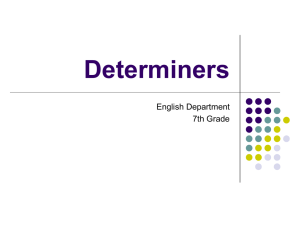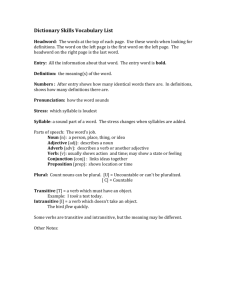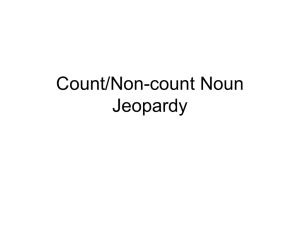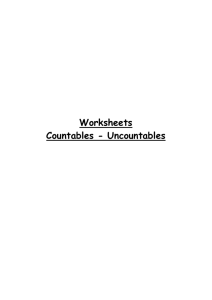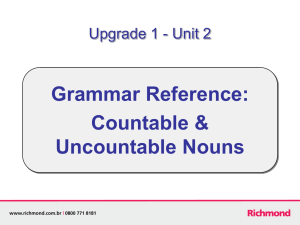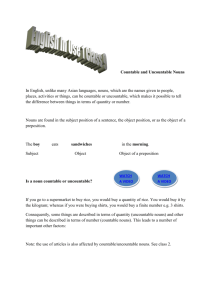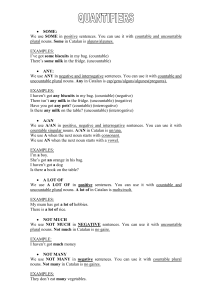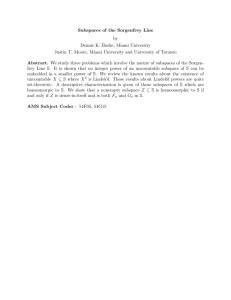English in Use 1 Self study Class 10 Using There is and there are
advertisement
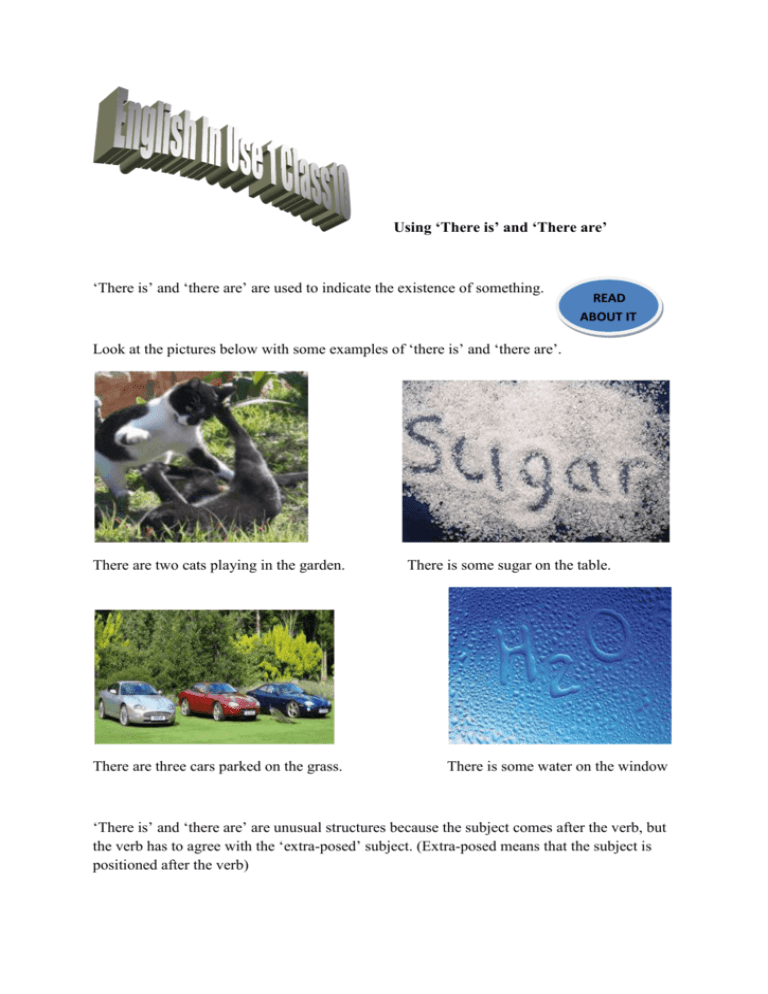
Using ‘There is’ and ‘There are’ ‘There is’ and ‘there are’ are used to indicate the existence of something. READ ABOUT IT Look at the pictures below with some examples of ‘there is’ and ‘there are’. There are two cats playing in the garden. There are three cars parked on the grass. There is some sugar on the table. There is some water on the window ‘There is’ and ‘there are’ are unusual structures because the subject comes after the verb, but the verb has to agree with the ‘extra-posed’ subject. (Extra-posed means that the subject is positioned after the verb) ‘There is’ is used for singular nouns: There is a boy in the swimming pool. (One boy) PRACTICE There is a car parked outside my house. (One car) ‘There is’ is also used for uncountable nouns: PRACTICE There is too much sugar in my coffee. (an excessive quantity) There is a lot of rice in China. (a large quantity) PRACTICE ‘There are’ is used for plural (countable) nouns: There are three boys in the swimming pool. There are two cars parked outside my house. PRACTICE There are many trees in the forest. Use of ‘there is/there are’ We use ‘there ís /there are’ to describe the existence of something. In Thai, the verb ‘mee’ (มี) is used in a similar way. This translates to the English verb ‘have’ but is not always used in the same way. 1) Describing places and other things If you are describing your house, you could say: ‘There are four bedrooms in my house’ or ‘My house has four bedrooms’ If you are describing your class, you could say: ‘There are 20 students in my class’ or ‘My class has 20 students’ If you are describing your course, you could say: ‘There are many choices of subject on my course’ If you are describing a car, you could say: ‘There are four seats in my car’ WATCH A VIDEO 2) Describing situations e.g. news reporting. For example: ‘There is a group of protesters outside Parliament’. (singular) ‘There is a big storm approaching Thailand’. (uncountable) ‘There is increasing unemployment in Europe.’ (Uncountable) ‘There are many problems with the new policy’. (plural) ‘There are large numbers of refugees leaving Syria’. (plural) 3) Making observations for academic purposes When writing essays, reports or dissertations, it is necessary to make observations about previous research, experiments and results. For example, ‘There is much research that has investigated the effects of promotions on sales’ (uncountable) ‘There are three major findings in this report’ (countable) In essays, ‘there is/there are’ is used in topic sentences: ‘There are many problems when living in big cities’ ‘There are many advantages associated with the use of modern technology’ ‘There is much debate about the environment’ 4) Asking about the existence of things The pronoun ‘there’ and the verb can be reversed to ask questions: WATCH A VIDEO Are there any foreign students in your class? (countable) Are there any restaurants near here? (countable) PRACTICE Is there any sugar in your coffee? (uncountable) Is there any flooding in your city? (uncountable) Is there a restaurant in your street? (singular) Note: We use ‘any’ in questions and negative statements (e.g. No. There aren’t any restaurants near here). Task: Look at the picture and match the description with the picture. 1 4 7 2 5 8 3 6 9 There are three birds sitting on a rock. There is a fast boat, and there are many people on it. There is a man playing golf. There is a man opening a gate. There are some yachts sailing in the sea. There is a man climbing a hill to as castle. There is a man riding a bicycle. There is a man sitting on a bike, admiring the view. There are three men going diving. 8 4) Negative statements There isn’t There isn’t any sugar in the kitchen. (uncountable) There isn’t any water in the fridge. (uncountable) PRACTICE There aren’t There aren’t any students in the classroom. (countable/plural) There aren’t any books in my bag. PRACTICE (countable/plural) PRACTICE Task: Look at the pictures and answer the questions How many cats are there in the picture? How many apples are there in the picture? How many children are there in the picture? How many cars are there in the picture? How many bananas are there in the picture? How many trees are there in the picture? Task: Insert the missing verb in the sentence 1. There ....... 45 new students on my course. 2. There ...... a lot of water on the kitchen floor. 3. There ...... a lot of pollution in Bangkok. 4. There ...... three oranges in my bag. 5. There ...... many fish in the sea. 6. There ...... a policeman in the shop. 7. There ...... some sugar in my tea. 8. There ...... a lot of people in the stadium. 9. There ...... a lot of milk in the supermarket. 10. There ...... many empty seats on the train. CLICK HERE TO DO THIS EXERCISE ONLINE


